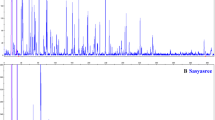Abstract
Bermudagrasses (Cynodon spp.) are major turfgrasses for home lawns, public parks, golf courses and sport fields, and are widely adapted to tropical and warmer temperate climates. Morphological and physiological characteristics are not sufficient to differentiate some bermudagrass genotypes because the differences between them are often subtle and subject to environmental influence. In this study, a DNA-typing technique, amplified fragment length polymorphism (AFLP), was used to differentiate bermudagrass genotypes and to explore their genetic relationships. Twenty seven bermudagrass cultivars and introductions, mostly from the Coastal Plain Experiment Station in Tifton, Ga., were assayed by the radioactive (32P) and the fluorescence-labeled AFLP methods. The AFLP technique produced enough polymorphism to differentiate all 27 bermudagrass genotypes, even the closely related ones. An average of 48–74 bands in the 30–600-bp size range was detected by the 32P-labeled AFLP method. The results indicated that most of the 14 primer combinations tested in this study could be used to distinguish bermudagrass genotypes, and that some single primer-pairs could differentiate all 27 of them. To test the reliability and reproducibility of the AFLP procedure, three DNA isolations (replications) of the 27 bermudagrass genotypes were assayed using five primer pairs. Only 0.6% of the bands were evaluated differently among the three replications. One replication of one genotype (which was most likely a planting contaminant) was grouped in an unexpected cluster using the Unweighted Pair Group Mean Average (UPGMA) method. A one- or two-band difference in scoring did not change the clustering of genotypes or the replications within genotypes. The 27 genotypes were grouped into three major clusters, many of which were in agreement with known pedigrees. Trees constructed with different primer combinations using 32P- and fluorescence-labelling formed similar major groupings. The semi-automated fluorescence-based AFLP technique offered significant improvements on fragment sizing and data handling. It was also more accurate for detection and more efficient than the radioactive labelling method. This study shows that the AFLP technique is a reliable tool for differentiating bermudagrass genotypes and for determining genetic relationships among them.
Similar content being viewed by others
Author information
Authors and Affiliations
Additional information
Received: 28 July 1998 / Accepted: 3 November 1998
Rights and permissions
About this article
Cite this article
Zhang, LH., Ozias-Akins, P., Kochert, G. et al. Differentiation of bermudagrass (Cynodon spp.) genotypes by AFLP analyses. Theor Appl Genet 98, 895–902 (1999). https://doi.org/10.1007/s001220051148
Issue Date:
DOI: https://doi.org/10.1007/s001220051148




